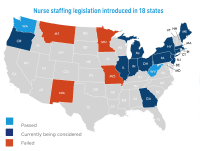Prescription drug abuse and diversion is a silent epidemic touching thousands of lives and tearing apart families all across America. For my family, it’s personal. Reading about it is one thing, experiencing it is another.
Many of us are guardians for aging parents and know firsthand the challenging issues surrounding elder care. Overnight, we’re faced with fulltime oversight at home or in an institution. Medication management, feeding, and bathing are issues we expect to address. Drug abuse or worse, drug diversion, are ones we don’t.
Nurses are on the front line of caregiving, as well as abuse detection. But a harried day and heavy workload can cause us to miss subtle signs. For instance, those diverting drugs can be very smart and go unnoticed for a long time. I know. It happened right under my nose.
A national crisis
Addiction rates are soaring. The death toll from prescription painkillers has more than tripled in the past decade. More than 40 people die every day from overdoses involving narcotic pain relievers like hydrocodone (Vicodin), methadone, oxycodone (OxyContin), and oxymorphone (Opana).
“Overdoses involving prescription painkillers are at epidemic levels and now kill more Americans than heroin and cocaine combined,” said Centers for Disease Control and Prevention (CDC) Director Thomas Frieden, MD, MPH. “Everyone has critical roles to play in the national effort to stop this epidemic, while we protect patients who need prescriptions to control pain.”
The increased use of prescription painkillers for nonmedical reasons (for the high they cause), along with growing sales, has contributed to the large number of overdoses and deaths. Based on the data from the Drug Enforcement Administration, sales of these drugs to pharmacies and healthcare providers have increased by more than 300% since 1999! 300%!
Healthcare providers who have easier access to these drugs than the public can be particularly vulnerable. For some, the economics of today’s world might incentivize “street sales” to supplement strained incomes. I learned that the cost of generic oxycodone in a nursing home can be as cheap as 60 cents a pill, but the street value for that same pill can be as high as $15 or more. That’s quite a profit margin.
It didn’t add up
When my father-in-law fell and broke his hip, he was too frail for a hip replacement under general anesthesia. Using only a spinal anesthetic, three screws were inserted to stabilize the hip bone. With little post-op pain, he only needed acetaminophen to control discomfort while in the hospital.
That’s why we were confused after his hospitalization when oxycodone appeared on the medication administration record and on drug invoices. Audits of pharmacy and medical records only heightened our confusion. Something just didn’t add up.
Inconsistent stories from some caregivers didn’t add up either. Hours rolled into days as we tried to piece together fragmented facts. It was weeks before we had our documentation complete and were able to meet with the attending physician and CEO/administrator, who agreed to immediately make changes tightening the system. As of this writing, the case is still active, so a few of the details can’t be disclosed yet.
But so far, the three lessons for us are points for you to know:
- The epidemic is real. Learn the subtle signs that signal drug abuse or drug diversion activity might be happening around you. Understand the stories behind the headlines.
- Cheap painkillers can be actually be very costly. Addiction is taking an expensive toll on our society, often silently.
- Confront reality. If you suspect something, say something. Nurses, no matter where they practice, have assessment skills that can detect signs that something might be wrong.
The next time you see an article about the oxycodone epidemic or prescription painkiller diversion in healthcare facilities, please don’t just glance at it. Read it. It just might be a story about someone you know.
Note: Read more about this topic in the American Nurse Today archives:
Blozen BB. Prescription opioids: A growing epidemic of abuse. Am Nurs Today. 2013;8(11).
Carpenter H. The painful problem of drug diversion and what you can do. Am Nurs Today. 2014; 9(12).
Worley J. Doctor shopping and prescription substance use disorders: A nursing response. Am Nurs Today. 2015;10(6).


















